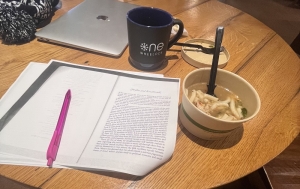
"Tied to the Earth with a Clamp": My Class on Virginia Woolf
The first thing you should know about Creative Writing (CRWT) 40.12: Novels of Virginia Woolf: Radical Innovator, which I'm taking this term, is that it's held in the Wren Room in the Sanborn Library, home of the English department (and where tea is famously served every afternoon). The Wren Room is almost indescribably perfect for a literature course, overloaded with dark academia vibes (as the kids say, though—of course—this room dates to well before "dark academia" was even a thing) and a gorgeous chandelier. It's an eight-student seminar, and we sit in a circle around a table for two hours every Tuesday and Thursday afternoon to discuss, well, Virginia Woolf.
I'd never read any Virginia Woolf before enrolling in this course; in fact, it was originally a backup option when I didn't get into CRWT 11 (Introduction to Creative Nonfiction, a 12-spot class where sophomores get first-come, first-serve priority). Now, just a week in, though I'm sure I would've loved CRWT 11, I am so, so happy that I ended up in this class. I went in having heard Virginia Woolf quoted and referenced hundreds of times over the course of my life, as I'm sure many of us have, but without having opened a single book of hers. The tidbits of her life story that I'd heard always fascinated me, though, so I couldn't wait to dive in.

The class itself is taught by Prof. Peter Orner, who reminds us at every turn that no matter how lost you might get in one of Woolf's longer, more meandering sentences, she'll always bring you back to the ground: her work is "tied to the Earth with a clamp," he tells us. Just a few classes in, having started the course off with some of her short stories, not having opened Mrs. Dalloway or To the Lighthouse yet, I'm already feeling that. There's something at once haunting and grounding about Woolf's prose. That it evokes memories I didn't completely know I had—and the ghosts thereof—is the only way I can find to begin to explain it.
I've found myself turning the one-page "Monday or Tuesday" over and over from every angle in my brain. So much packed into five quick paragraphs: a heron, waiting for truth, smoke trails, firelight, truth, marble squares, the truth . . . a rush closed out by "Lazy and indifferent the heron returns; the sky veils her stars; then bares them." The reader is left in an overwhelming, almost frigid, quiet. I know this blog isn't the place for extensive analysis; I just want to speak briefly about the profoundly inexplicable feeling of reading Woolf's work. And yet, at the same time, Prof. Orner reminds us, we need not place her, or even her work, on a pedestal but rather aim to engage with her work as is and without presumption, with a concept of her as an ordinary person who most certainly had her flaws of all kinds.
I'm just at the outset of this course, so I'm certain this is by no means a comprehensive look at the class or everything else I've yet to experience and learn in it, but even at this point, I'm just so appreciative of the opportunity to take this class. To me, it epitomizes a lot of what's so great about a Dartmouth education—the chance to take courses in a wide variety of very specific topics, even if they aren't in your major, even if they aren't something you'd ever previously thought of studying, and discover something that's a pleasant surprise and really gets you excited. I've found that time and time again here at Dartmouth, not just through courses but in other moments where I've done something (joined a club or gone somewhere with friends) on a whim and ended up with one of my favorite experiences of my whole time in college. I should probably go get started on Mrs. Dalloway—I can't wait to see what else this class has in store for me this term!
















